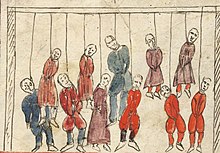This article has multiple issues. Please help improve it or discuss these issues on the talk page. (Learn how and when to remove these template messages)
|
The sons of Haman were ten men mentioned by name in the biblical book of Esther who were killed on the 13th of Adar and hanged the following day, the 14th of Adar.[1][2]


The names of Haman's ten sons have been variously interpreted in terms of their possible Iranian forms. Some of the names can reasonably be considered to be Iranian, but it is difficult to notice a clear pattern of Iranian forms in them.[3] The names given in the biblical text are:
According to the Talmud, Haman had many other sons. Talmudic scholars disagreed on the number of Haman's sons; according to one account, there were thirty: ten died, ten were hanged, and ten became beggars. According to the rabbis, the beggars numbered seventy; according to Rami bar Abi, there were a total of two hundred and eight sons in all.[2] Rashi explains that those ten who were killed and hanged are the ones who wrote hateful words about the Jews and Jerusalem.[citation needed] The Hebrew text displays peculiarities. It can be noted that the names of Haman's ten sons are written vertically, one below the other, in a column; according to Jewish tradition, this indicates that they were hanged one above the other on an extremely tall gallows.[9]
R. Mordechai Sasson explains that Haman symbolizes the Yetzer Harah (evil inclination), and his ten sons allude to his ten traits of bad character. Their deaths represent the elimination of these evil traits when defeated by the Yetzer Tov (good inclination). He explains the meaning of each name and how each corresponds to a type of evil.[10]